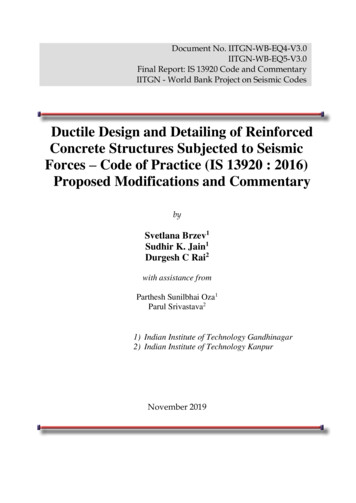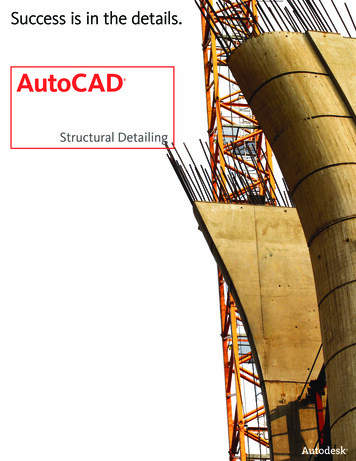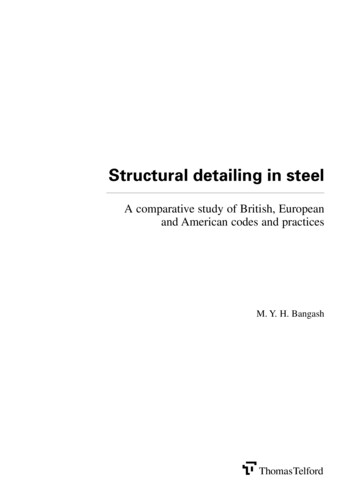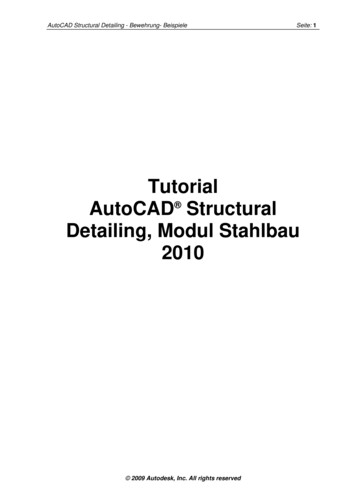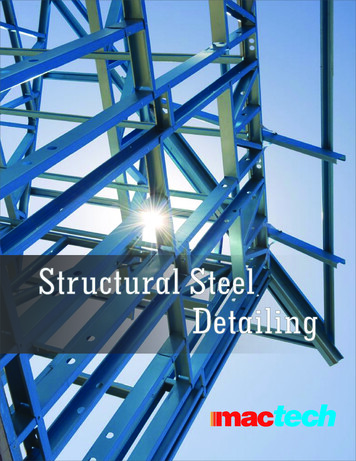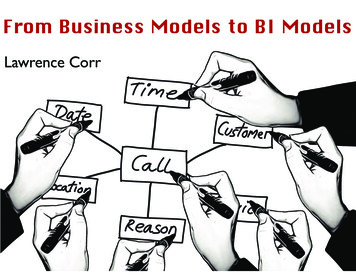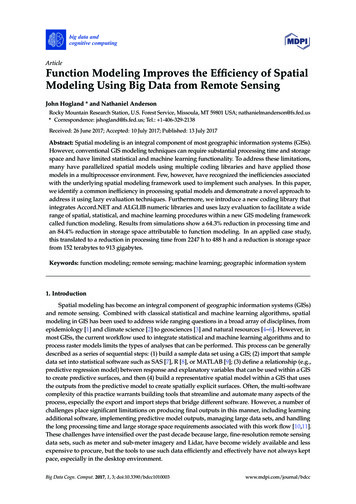
Transcription
View metadata, citation and similar papers at core.ac.ukbrought to you byCOREprovided by International Journal of Science Engineering and Advance Technology (IJSEAT)International Journal of Science Engineering and AdvanceTechnology, IJSEAT, Vol. 3, Issue 11ISSN 2321-6905November-20153d Modeling and Detailing of Silumin Piston With Static Analysis1Kammila V Prudhvi Raj Kiran, 2 Sanmala Rajasekhar, 3A.V.Sridhar, 4J.Harinarayana Rao1M. Tech. Student, 2Associate.Professor, 3Associate.ProfessorDept of ME, KITS, Divili.4Reserch ScholarAbstract: - Piston is the part of engine whichconverts heat and pressure energy liberated by fuelcombustion into mechanical works. Engine piston isthe most complex component among theautomotives. Weight reduction has been gainingimportance in automobile field because reducing inweight decreases load on the engine and thusincreasing efficiency of the engine. As we all Knowthat Piston is made of Aluminum Alloy Such that itsweight is less. The automobile industry has shownincreased interest in replacing the Piston with thematerial having high strength to weight ratio.Therefore the objective of this project is topresent a general study on the performancecomparison of composite Piston and AluminumAlloy Piston. Dimensions and specifications used inmodeling are collected from the actual Piston ofHero-Honda Splendor Bike. The Piston is modelingin solid Works.1. INTRODUCTION A piston is a cylindrical piece of metal thatmoves up and down inside the cylinderwhich exerts a force on a fluid inside thecylinder.Pistons have rings which serve to keep theoil out of the combustion chamber and thefuel and air out of the oil. Most pistons fittedin a cylinder have piston rings. Usually thereare two spring compression rings that act asa seal between the piston and the cylinderwall and one or more oil controls below thecompression rings.The head of the piston can be flat, bulged orotherwise shaped.Pistons can be forged or cast.The shape of the piston is normally roundedbut can be different.A special type of cast piston is thehypereutectic piston.www.ijseat.com The piston is an important component of apiston engine and of hydraulic pneumaticsystems .Piston heads form one wall of an expansionchamber inside the cylinder.The opposite wall, called the cylinder head,contains inlet and exhaust valves for gases.As the piston moves inside the cylinder, ittransforms the energy from the expansion ofa burning gas usually a mixture of petrol ordiesel and air into mechanical power in theform of a reciprocating linear motion.From there the power is conveyed through aconnecting rod to a crankshaft, whichtransforms it into a rotary motion, whichusually drives a gearbox through a clutch.1.1 CLASSIFICATION OF PISTONTrunk pistons:Trunk pistons are long, relative to theirdiameter. They act as both piston and also as acylindrical crosshead. As the connecting rod isangled for part of its rotation, there is also a sideforce that reacts along the side of the piston againstthe cylinder wall. A longer piston helps to supportthis.Trunk pistons have been a common designof piston since the early days of the reciprocatinginternal combustion engine. A characteristic of mosttrunk pistons, particularly for diesel engines, is thatthey have a groove for an oil ring below the gudgeonpin, not just the rings between the gudgeon pin andcrown.The name 'trunk piston' derives from the'trunk engine', an early design of marinesteamengine.To make these more compact, they avoided the steamengine's usual piston rod and separate crosshead andwere instead the first engine design to place thegudgeon pin directly within the piston. Their 'trunk'was a narrow cylinder placed mounted in the centreof this piston.Page 883
International Journal of Science Engineering and AdvanceTechnology, IJSEAT, Vol 3, Issue 11FIG 1.1: TRUNK PISTONCrosshead pistonsLarge slow-speed Diesel engines mayrequire additional support for the side forces on thepiston. These engines typically use crosshead pistons.The main piston has a large piston rod extendingdownwards from the piston to what is effectively asecond smaller-diameter piston. The main piston isresponsible for gas sealing and carries the pistonrings. The smaller piston is purely a mechanicalguide. It runs within a small cylinder as a trunk guideand also carries the gudgeon pin.Because of theadditional weight of these pistons, they are not usedfor high-speed engines.ISSN 2321-6905November-2015flow within the cylinder must be carefully directed inorder to provide efficient scavenging. With crossscavenging, the transfer (inlet to the cylinder) andexhaust ports are on directly facing sides of thecylinder wall. To prevent the incoming mixturepassing straight across from one port to the other, thepiston has a raised rib on its crown. This is intendedto deflect the incoming mixture upwards, aroundthe combustion chamber. Much effort, and manydifferent designs of piston crown, went intodeveloping improved scavenging. The crownsdeveloped from a simple rib to a large asymmetricbulge, usually with a steep face on the inlet side and agentle curve on the exhaust.Despite this, cross scavenging was never aseffective as hoped. Most engines todayuse Schnuerleporting instead. This places a pair oftransfer ports in the sides of the cylinder andencourages gas flow to rotate around a vertical axis,rather than a horizontal axis.Slipper pistonsA slipper piston is a piston for a petrolengine that has been reduced in size and weight asmuch as possible. In the extreme case, they arereduced to the piston crown, support for the pistonrings, and just enough of the piston skirt remaining toleave two lands so as to stop the piston rocking in thebore. The sides of the piston skirt around the gudgeonpin are reduced away from the cylinder wall. Thepurpose is mostly to reduce the reciprocating mass,thus making it easier to balance the engine and sopermit high speeds. A secondary benefit may besome reduction in friction with the cylinder wall,however as most of this is due to the parts of thepiston that are left behind, the benefit is minor.FIG 1.2: SLIPPER PISTONDeflector pistons:Deflector pistons are used in two strokeengines with crankcase compression, where the gaswww.ijseat.comFIG 1.3: DEFLECTOR PISTON2. MATERIAL SELECTION FOR PISTON2.1 Materials Used For Piston Cast iron (used in very old engines) Cast aluminum (most common) Hypereutectic alloys (high silicon contentaluminum-Silumin) Carbon Graphite (being tested)2.2 Aluminium Alloy:The most common material used for automotivepistons is aluminium alloy due to its lightweight, lowcost and acceptable strength. Silicon is the majoralloying element added to aluminium, which offersweight reduction to the piston.Page 884
International Journal of Science Engineering and AdvanceTechnology, IJSEAT, Vol 3, Issue 112.3Chemical 03Al98.751Table 1: Composition of Al-Alloy2.3 Causes of Piston Failures The piston is one of the most stressedcomponents of an entire vehicle. As an important part in an engine pistonendures the cyclic gas pressure and inertiaforces at work and this working conditionmay cause the fatigue damage of the piston. The investigations indicate that greateststress appears on the upper end of the pistonand stress concentration is one of the mainlyreason for fatigue failure Pressures at the combustion chamber mayreach about 180–200 bar Speeds reach about25 m/s and temperatures at the piston crownmay reach about 400 C As one of the major moving parts in thepower-transmitting assembly, the pistonmust be designed so that it can withstand theextreme heat and pressure of combustion. Pistons must also be light enough to keepinertial loads on related parts to a minimum. It also transmits heat to the cooling oil andsome of the heat through the piston rings tothe cylinder wall. Notwithstandingthistechnologicalevolution there are still a significant numberof damaged pistons. Damages may havedifferent origins: mechanical edegradation,oxidationmechanisms and etc. Fatigue is a source of piston damages. Although, traditionally, piston damages areattributed to wear and lubrication sources,fatigue is responsible for a significantnumber of piston damages. And some damages where the main cause isattributed to wear and/or lubricationwww.ijseat.comISSN 2321-6905November-2015mechanisms may have in the root causeorigin a fatigue crack. Fatigueexistswhencyclicstresses/deformations occur in an area on acomponent. The cyclic stresses/deformations havemainly two origins: load and temperature. Traditional mechanical fatigue may be themain damaging mechanism in different partsof a piston depending on different factors.High temperature fatigue (which includescreep) is also present in some damagedpistons. Thermal fatigue and thermal–mechanicalfatigue are also present in other damagedpistons.Mechanical fatigue damages at piston head andpiston pin holes is the reason of several damagedengine pistons. Static stresses concentrate mainly atpin holes both for petrol and diesel pistons, as wellas for automotive, train, and other engine fields. Thisexplains cracks initiated at piston pin holes.3. FINITE ELEMENT ANALYSISThe Finite Element Method (FEM) hasdeveloped into a key, indispensable technology in themodeling and simulation of advanced engineeringsystems in various fields like housing, transportation,communications, and so on. In building suchadvanced engineering systems, engineers anddesigners go through a sophisticated process ofmodeling, simulation, visualization, analysis,designing, prototyping, testing, and lastly, fabrication.Note that much work is involved before thefabrication of the final product or system.This is to ensure the workability of thefinished product, as well as for cost effectiveness.The process is illustrated as a flowchart in Figure 6.1.This process is often iterative in nature, meaning thatsome of the procedures are repeated based on theresults obtained at a current stage, so as to achieve anoptimal performance at the lowest cost for the systemto be built. Therefore, techniques related to modelingand simulation in a rapid and effective way play anincreasingly important role, resulting in theapplication of the FEM being multiplied numeroustimes because of this.Page 885
International Journal of Science Engineering and AdvanceTechnology, IJSEAT, Vol 3, Issue 11ISSN 2321-6905November-2015Piston diameter49.5mmPin hole externaldiameter12.7 mmPin hole internaldiameter6.6 mmPiston ring axialthickness0.8mmRadial thickness ofring2mmDepth of ring groove2.01mmGap between theRings2.6mmTop land thicknessFigure 3.1: The design ProcessThe very basic concept of FEM is a systema-body of a structure can be divided elements of damental concept of the finite element method isthat any continuous quantity, such as temperature,pressure or displacements can be approximated by adiscrete model composed of set of piece wisecontinuous functions defined over a finite number ofsub domains. These series of functions are piecewisecontinuous and should approach the exact solution asthe number of sub domains approaches infinity. FEMis more appealing to the engineer as it can beexplained through the physical concept and also forheat transfer and fluid mechanics. It is amenable forprogramming on a digital computer in a systematicway. The scope of application is practically verymuch large covering wide range of analysis problems.4. DESIGN MODEL OF PISTONDesign of Piston:The Piston is Designed Based on thefollowing dimensions of Hero-Honda bike Piston.Design of piston is carried out in the Solid works.5.6mmThickness of piston at6.65mmTopThickness of piston at1.64mmopen endTable4.1: Dimensions of The Piston4.1 SOLID WORKSSolid Works is a 3D mechanical CAD(computer-aided design) program that runs onMicrosoft Windows and is being developed byDassault Systems Solid Works Corp. Solid Works iscurrently used by over 2 million engineers anddesigners at more than 165,000 companiesworldwide. FY2011 revenue for Solid Works was483 million dollars.Dimensions of the piston:ParameterPiston lengthwww.ijseat.comActualValues37 mmFIG 4.1: DESIGN OF THE PISTON4.1.1 Meshed model of PistonMeshing is nothing but the discretization ofobject into the small parts called as the element. Thisanalysis is limited up to the 2D analysis thereforePage 886
International Journal of Science Engineering and AdvanceTechnology, IJSEAT, Vol 3, Issue 11ISSN 2321-6905November-2015only quad and triangular elements are used. Figureshows the meshed model of a piston.FIG 4.2 MESHED MODEL OF PISTONFIG4.4: VON MISES STRESS FOR SILUMINPISTON4.2 STUDY RESULTS4.2.1 STRESS Analysis:Figure shows the equivalent Von-Mises stressinduced in Al-Alloy Piston and Silumin under theaction of 3.15*106 N/m2 load. The maximum stress isinduced in Al-Alloy is 5.4*1011N/m2 and maximumstress is induced in Silumin Alloy is 2.76 *1011N/m2Red zone indicates the area of maximum stress andblue zone indicates the area of minimum stress.FIG 4.5: DISPLACEMENT FOR AL-ALLOYPISTONFIG 4.3: VON MISES STRESS FOR THE ALALLOY PISTONFIG 4.6: DISPLACEMENT SILUMIN PISTONwww.ijseat.comPage 887
International Journal of Science Engineering and AdvanceTechnology, IJSEAT, Vol 3, Issue 11ISSN 2321-6905November-2015Displacement, and Max Stress for the SILUMINAlloy piston are less than that of Al-Alloy Piston. soin future SILUMIN Alloy can be adopted in thecommercial automobiles to enhance the performancerange of the engine from piston’s side. The analysisis carried out in the commercially available softwareSolid Works.REFERENCES[1] Design and Analysis of Piston Design for 4Stroke Hero Bike Engine by odyadav@hotmail.com &Dr. N. D. MittalProfessor, Applied Mechanics,MANIT Bhopal International Journal of Engineering Innovation &Research Volume 2, Issue 2, ISSN: 2277 – 5668.FIG 4.7: STRAIN FOR AL-ALLOY PISTON[2] Thermal Cyclic Fatigue Analysis of hito Hayashi of TokaiUniversity, Faculty of Engineering, Department ofMaterial Science, 259-1292 Hiratsuka, Kanagawa,Japan-International Journal of Material andMechanical Engineering, 2012, 1: 57-60.FIG 4.8:STRAIN FOR SILUMIN PISTONRESULTSComparisons:Mater Weigh MaxMaxMaxialt (N)StressDisplaceme StrainUsed(N/m 2 nt (mm))Al0.3660 5.4874668.24.3712024- 86e 01136T6SILU 0.3476 2.7464314.7772.062MIN51e 01189Table:Comparisons Between the MaterialsCONCLUSIONIn this project, a piston is modeled in 3D modelingsoftware SOLIDWORKS. Present used material forpiston is Cast Aluminum. The Cast aluminum isreplaced with SILUMIN. The weight of the piston isless since its density is less.Static analysis is done on the piston byapplying the pressure to verify the strength of thepiston using 2 materials. The Max Strain,www.ijseat.com[3] Piston Strength Analysis Using FEM by Swati SChougule (Second Year M.E. CAD/CAM &Robotics, Department of Mechanical Engineering,PIIT, New Panvel, Mumbai University, NaviMumbai,) &,Vinayak H Khatawate(Asst. Prof.Department of Mechanical Engineering, PIIT, NewPanvel, Mumbai University, Navi Mumbai)International Journal of Engineering Research andApplications(IJERA)ISSN:2248-9622www.ijera.com Vol. 3, Issue 2, March -April 2013,pp.1724-1731 1724.[4] Parametric And Material Optimization Of TwoWheeler Piston Using Aluminum Alloy iAshok,Mohammedzubairnizami-Department of Mechanical EngineeringLords Institute of Engineering & urnal ofAdvanced Trends in Computer Science andEngineering.[5] Piston Damages – Case Studies AndPossibilitiesof Early Detection by Jan logyFaculty of TransportKrasinskiego polsl.pl-Journal of KONES Powertrainand Transport.Page 888
International Journal of Science Engineering and AdvanceTechnology, IJSEAT, Vol 3, Issue 11ISSN 2321-6905November-2015[6] Fatigue on engine pistons – A compendium ofcase studies by F.S.SilvaDepartment of MechanicalEngineering, University of Minho, Azure m, 4800058Guimara es,PortugalWWW.Sciencedirect.Com.[7] Aluminum Silicon Carbide (Al-Sic) for AdvancedMicroelectronic Packages by Mark Occhionero,Richard Adams, Kevin Fennessy, and Robert A.HayCeramics Process Systems, Corp.Chartley, MA02712.[8] Pistons and cylinders made of carboncarboncomposite materialsUS 6044819 A by G.Burton Northam, Philip O. Ransone, H. KevinRivers, Francis A. Schwind.-The United States OfAmerica As Represented By The Administrator OfThe National Aeronautics And Space Administration.www.ijseat.comPage 889
much large covering wide range of analysis problems. 4. DESIGN MODEL OF PISTON Design of Piston: The Piston is Designed Based on the following dimensions of Hero-Honda bike Piston. Design of piston is carried out in the Solid works. Dimensions of the piston: Parameter Actual Values Piston length 37 mm Piston diameter 49.5mm Pin hole external .

